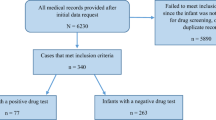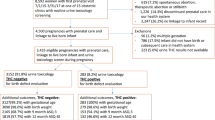Abstract
Objective:
Examine the risk of preterm birth (PTB) among women who use drugs during pregnancy and have elevated α-fetoprotein (AFP).
Study Design:
The sample included California singleton live births in 2005 to 2010 contained within a hospital discharge database linked to the Prenatal Screening Program. A selection of mothers who did not use drugs was selected at a ratio of 4:1. Risk of PTB was calculated using adjusted odds ratios and 95% confidence intervals (CIs) for women who did or did not use drugs by their AFP percentile.
Results:
We identified 7190 women who used drugs and selected 28 760 women who did not. Of women using cocaine with AFP ⩾95th percentile, 43.8% delivered prematurely. Women using drugs with AFP ⩾95th percentile were 11 to 35 times as likely to deliver <32 weeks.
Conclusion:
The combination of drug use and elevated AFP results in high rates of PTB. This combination results in an additive risk.
This is a preview of subscription content, access via your institution
Access options
Subscribe to this journal
Receive 12 print issues and online access
$259.00 per year
only $21.58 per issue
Buy this article
- Purchase on Springer Link
- Instant access to full article PDF
Prices may be subject to local taxes which are calculated during checkout


Similar content being viewed by others
References
Jelliffe-Pawlowski LL, Baer RJ, Blumenfeld YJ, Ryckman KK, O'Brodovich HM, Gould JB et al. Maternal characteristics and mid-pregnancy serum biomarkers as risk factors for subtypes of preterm birth. BJOG 2015; 122 (11): 1484–1493.
Baer RJ, Currier RJ, Norton ME, Flessel MC, Goldman S, Towner D et al. Obstetric, perinatal, and fetal outcomes in pregnancies with false-positive integrated screening results. Obstet Gynecol 2014; 123 (3): 603–609.
Jelliffe-Pawlowski LL, Baer RJ, Currier RJ . Second trimester serum predictors of preterm birth in a population-based sample of low-risk pregnancies. Prenat Diagn 2010; 30 (8): 727–733.
Alleman BW, Smith AR, Byers HM, Bedell B, Ryckman KK, Murray JC et al. A proposed method to predict preterm birth using clinical data, standard maternal serum screening, and cholesterol. Am J Obstet Gynecol 2013; 208 (6): 472 e471–411.
Gorman MC, Orme KS, Nguyen NT, Kent EJ III, Caughey AB . Outcomes in pregnancies complicated by methamphetamine use. Am J Obstet Gynecol 2014; 211 (4): 429 e421–e427.
Ladhani NN, Shah PS, Murphy KE . Prenatal amphetamine exposure and birth outcomes: a systematic review and metaanalysis. Am J Obstet Gynecol 2011; 205 (3): 219 e211–217.
Burns L, Mattick RP, Cooke M . The use of record linkage to examine illicit drug use in pregnancy. Addiction 2006; 101 (6): 873–882.
Quesada O, Gotman N, Howell HB, Funai EF, Rounsaville BJ, Yonkers KA . Prenatal hazardous substance use and adverse birth outcomes. J Matern Fetal Neonatal Med 2012; 25 (8): 1222–1227.
Deutsch HF . Chemistry and biology of alpha-fetoprotein. Adv Cancer Res 1991; 56: 253–312.
Chen H, Egan JO, Chiu JF . Regulation and activities of alpha-fetoprotein. Crit Rev Eukaryot Gene Expr 1997; 7 (1-2): 11–41.
Bartha JL, Comino-Delgado R, Arce F, Alba P, Broullon JR, Barahona M . Relationship between alpha-fetoprotein and fetal erythropoiesis. J Reprod Med 1999; 44 (8): 689–697.
Bartha JL, Harrison G, Kyle PM, Soothill PW . Fetal serum alpha-fetoprotein in alloimmunised pregnancies. Prenat Diagn 2003; 23 (11): 917–920.
Jerzak M, Bischof P . Apoptosis in the first trimester human placenta: the role in maintaining immune privilege at the maternal–foetal interface and in the trophoblast remodelling. Eur J Obstet Gynecol Reprod Biol 2002; 100 (2): 138–142.
Liang OD, Korff T, Eckhardt J, Rifaat J, Baal N, Herr F et al. Oncodevelopmental alpha-fetoprotein acts as a selective proangiogenic factor on endothelial cell from the fetomaternal unit. J Clin Endocrinol Metab 2004; 89 (3): 1415–1422.
Dudich E, Semenkova L, Gorbatova E, Dudich I, Khromykh L, Tatulov E et al. Growth-regulative activity of human alpha-fetoprotein for different types of tumor and normal cells. Tumour Biol 1998; 19 (1): 30–40.
Mizejewski GJ . Levels of alpha-fetoprotein during pregnancy and early infancy in normal and disease states. Obstet Gynecol Surv 2003; 58 (12): 804–826.
Mizejewski GJ . Biological roles of alpha-fetoprotein during pregnancy and perinatal development. Exp Biol Med (Maywood) 2004; 229 (6): 439–463.
Salafia CM, Silberman L, Herrera NE, Mahoney MJ . Placental pathology at term associated with elevated midtrimester maternal serum alpha-fetoprotein concentration. Am J Obstet Gynecol 1988; 158 (5): 1064–1066.
American Medical Association International Classification of Diseases, Ninth Revision, Clinical Modification. AMA: Chicago, IL, USA, 2008.
Currier R, Wu N, Van Meter K, Goldman S, Lorey F, Flessel M . Integrated and first trimester prenatal screening in California: program implementation and patient choice for follow-up services. Prenat Diagn 2012; 32 (11): 1077–1083.
Kazerouni NN, Currier B, Malm L, Riggle S, Hodgkinson C, Smith S et al. Triple-marker prenatal screening program for chromosomal defects. Obstet Gynecol 2009; 114 (1): 50–58.
Kazerouni NN, Currier RJ, Flessel M, Goldman S, Hennigan C, Hodgkinson C et al. Detection rate of quadruple-marker screening determined by clinical follow-up and registry data in the statewide California program, July 2007 to February 2009. Prenat Diagn 2011; 31: 901–906.
Baer RJ, Flessel MC, Jelliffe-Pawlowski LL, Goldman S, Hudgins L, Hull AD et al. Detection rates for aneuploidy by first-trimester and sequential screening. Obstet Gynecol 2015; 126 (4): 753–759.
Norton ME, Baer RJ, Wapner RJ, Kuppermann M, Jelliffe-Pawlowski LL, Currier RJ . Cell-free DNA vs sequential screening for the detection of fetal chromosomal abnormalities. Am J Obstet Gynecol 2016; 214 (6): 727.e1–6.
Stoll BJ, Hansen NI, Bell EF, Shankaran S, Laptook AR, Walsh MC et al. Neonatal outcomes of extremely preterm infants from the NICHD Neonatal Research Network. Pediatrics 2010; 126 (3): 443–456.
Vohr BR, Wright LL, Poole WK, McDonald SA . Neurodevelopmental outcomes of extremely low birth weight infants <32 weeks' gestation between 1993 and 1998. Pediatrics 2005; 116: 635–643.
Doyle LW, Roberts G, Anderson PJ . Outcomes at age 2 years of infants <28 weeks' gestational age born in Victoria in 2005. J Pediatr 2010; 156 (1): 49–53 e41.
De Genna NM, Cornelius MD, Goldschmidt L, Day NL . Maternal age and trajectories of cannabis use. Drug Alcohol Depend 2015; 156: 199–206.
Substance Abuse and Mental Health Services Administration. Results from the 2012 National Survey on Drug Use and Health: Summary of National Findings, NSDUH Series H-46, HHS Publication No. (SMA) 13-4795. Substance Abuse and Mental Health Services Administration: Rockville, MD, USA, 2013..
Ganapathy VV, Prasad PD, Ganapathy ME, Leibach FH . Drugs of abuse and placental transport. Adv Drug Deliv Rev 1999; 38 (1): 99–110.
Ganapathy V . Drugs of abuse and human placenta. Life Sci 2011; 88 (21–22): 926–930.
Spong CY, Ghidini A, Dildy GA, Loucks CA, Varner MW, Pezzullo JC . Elevated second-trimester maternal serum hCG: a marker of inadequate angiogenesis. Obstet Gynecol 1998; 91 (4): 605–608.
Kutluer G, Cicek NM, Moraloglu O, Ertargin P, Sarikaya E, Artar I et al. Low VEGF expression in conceptus material and maternal serum AFP and beta-hCG levels as indicators of defective angiogenesis in first-trimester miscarriages. J Turk Ger Gynecol Assoc 2012; 13 (2): 111–117.
Greenwold N, Jauniaux E, Gulbis B, Hempstock J, Gervy C, Burton GJ . Relationship among maternal serum endocrinology, placental karyotype, and intervillous circulation in early pregnancy failure. Fertil Steril 2003; 79 (6): 1373–1379.
Acknowledgements
Data from the California Prenatal Screening Program were obtained through the California Biobank Program (Screening Information System request no. 476). Data were obtained with an agreement that the California Department of Public Health is not responsible for the results or conclusions drawn by the authors of this publication.
Author information
Authors and Affiliations
Corresponding author
Ethics declarations
Competing interests
The authors declare no conflict of interest.
Additional information
Supplementary Information accompanies the paper on the Journal of Perinatology website
Supplementary information
Rights and permissions
About this article
Cite this article
Baer, R., Chambers, C., Ryckman, K. et al. Risk of preterm birth among women using drugs during pregnancy with elevated α-fetoprotein. J Perinatol 37, 220–225 (2017). https://doi.org/10.1038/jp.2016.224
Received:
Revised:
Accepted:
Published:
Issue Date:
DOI: https://doi.org/10.1038/jp.2016.224
This article is cited by
-
Systematic Review: Polysubstance Prevalence Estimates Reported during Pregnancy, US, 2009–2020
Maternal and Child Health Journal (2023)
-
Genome-wide association study identifies a novel maternal gene × stress interaction associated with spontaneous preterm birth
Pediatric Research (2021)
-
Maternal anemia and pregnancy outcomes: a population-based study
Journal of Perinatology (2019)



